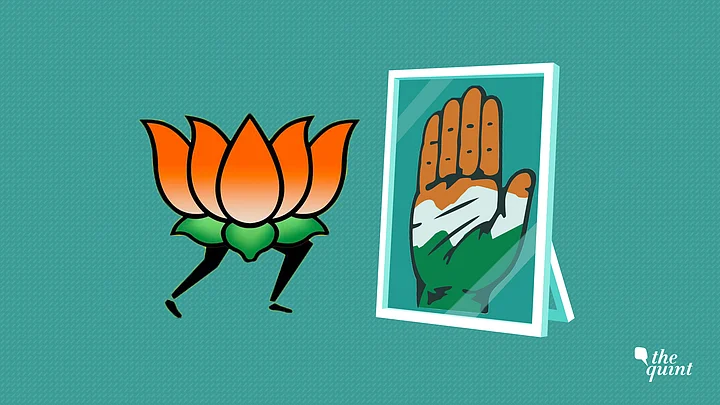The BJP has come a long way since its formation in 1980, with just two MPs In 1984 to 282 MPs in 2014. The transition from being a small party with a base only in the Hindi heartland, to gaining a pan-India presence, has been fascinating. The BJP, along with its allies, is now in power in 20 states; it is the largest party in the Rajya Sabha and has the highest percentage (35 percent) of MLAs in the country.
The BJP now rules over 65 percent of India’s population and 70 percent of the total area of the country. With the Congress now ruling only in four states, the BJP has successfully relegated the former to the status of a regional party.
Power in the Hands of Few
However, in trying to create a Congress-mukt Bharat, the BJP under Prime Minister Narendra Modi is fast becoming the new Congress, and herein lies the danger for the party.
While the Congress is all about the Gandhi family, the BJP is all about Modi today. The saffron party sought votes in the name of the prime minister in 2014, on the plank of ‘Abki Baar Modi Sarkar’. In many ways it was a vote for Modi only. After the Lok Sabha polls, his stature in the party and organisation has grown immensely. The BJP has contested most of the state elections banking on his leadership.
In June 2014, after the general elections, Modi ensured that his trusted lieutenant from Gujarat, Amit Shah, became the BJP president. This way he ensured total control of the government as well as the party organisation. Power rests with the now well-known trio of Modi, Shah and Arun Jaitley. Modi, like Indira Gandhi and then Rajiv and Sonia, has also not allowed any tall leader to grow.
The competition has been eliminated by formation of a ‘Margdarshak Mandal’ where the likes of Advani and Joshi have been parked. Relative light-weights have been made chief ministers in many states like Jharkhand and Haryana.
Move Over Swadeshi, BJP is all for FDI
In true ‘old Congress’ style, while all credit is given to Modi for wins in state elections, losses such as the ones in Delhi and Bihar are categorised as a ‘shared responsibility’. In its heyday, the Congress attracted many Opposition leaders and admitted them into their fold with open arms to boost its strength. The BJP is following the same policy, especially in states where it is weak.
Amit Shah’s philosophy is that if you don’t have a strong candidate for a seat, get one from outside, irrespective of ideology, recent examples being Naresh Agarwal and Narayan Rane. Since it has the resources, it is also seen using the same jod-tod methods of the old Congress regime to form state governments.
On the economic policy front, there is not much difference between the Congress and the BJP. While the party philosophy initially was swadeshi or self-reliance, it has taken forward the liberalisation and open market policy of PV Narasimha Rao. FDI is being welcomed in sectors like retail and defence.
Even schemes of the Congress which the BJP had criticised, like the NREGA and the FSB, have been advanced with much fervour.
The BJP also has a similar stance on corporate funding of elections and bringing political parties under the ambit of RTI. Both the Congress and the BJP got together to pass the retrospective foreign funding bill in Parliament recently to suit their interests.
Uninterrupted Power. But for How Long?
The two rival parties’ similarities don’t end here. Both the BJP and the Congress gained majorities almost 60 years after their respective inceptions. Congress party’s first tenure of power lasted 26 years from 1951-1977; the last was 10 years from 2004-14. With the Congress now significantly weakened, this question is on everyone’s minds: How long can this BJP government enjoy uninterrupted power? Till the end of last year, it was a given that Modi would rule at least till 2024.
The increased level of media penetration (TV / Print / Social Media) is making people more and more aware. News travels much faster today. People have become more ambitious and aspirational, at the same time impatient, wanting prompt delivery of promises.
All this points to the fact that the cycle of power may not last for 20+ years, like the Congress under Indira and Nehru enjoyed. The BJP may not be able to enjoy power for such a long stretch, but whether it will stop at 5 years or 10 or 15 is anybody’s guess.
To conclude, the general elections in many ways are an aggregation of elections in various states. As per a CSDS survey, in the 2014 elections, 18 percent people gave importance to the state-level leadership while voting. While the BJP won 2014 elections due to the Modi wave, it also did well in states where it had strong local leadership like in MP, Chhattisgarh, Rajasthan, Goa, Karnataka and Bihar among others. Promotion of state leaders could act as a cushion in case Modi’s popularity wanes.
The sooner the BJP realises that ‘Congress-isation’ will spell doom for it, and takes corrective measures, the better it will be for BJP’s longevity.
(The author is an independent political commentator and can be reached at @politicalbaaba. The views expressed above are the author’s own. The Quint neither endorses nor is responsible for the same.)
(At The Quint, we question everything. Play an active role in shaping our journalism by becoming a member today.)
